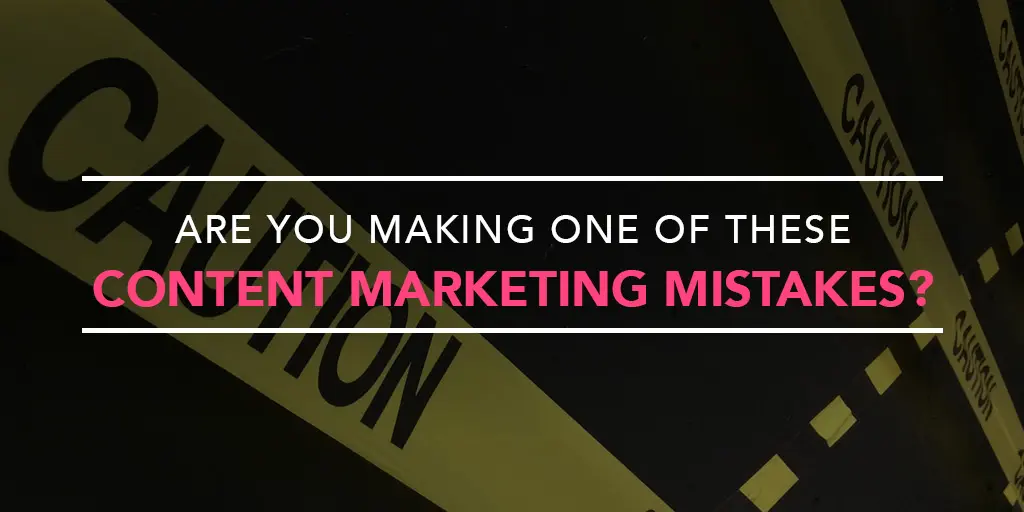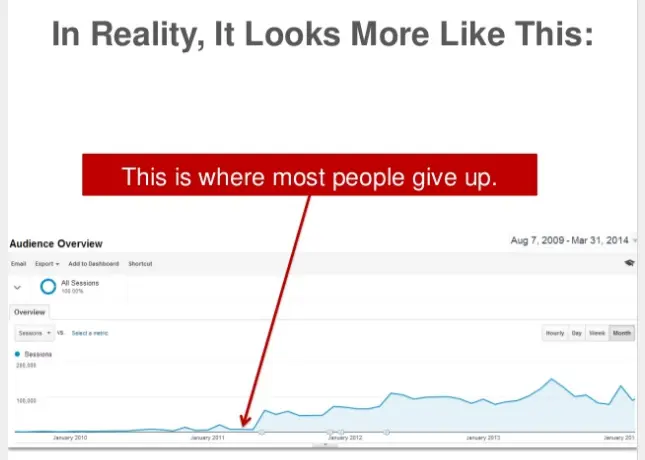- Mistake #1: Not Having a Specific, Measurable Goal
- Mistake #2: Not Having the Right Goal
- Mistake #3: Not Answering the Right Question
- Mistake #4: Not Speaking to the Right Person
- Mistake #5: Not Having the Right Voice
- Mistake #6: Not Going In Depth With Your Content
- Mistake #7: Not Providing Evergreen Pieces of Content
- Mistake #8: Not Being Patient
- Final Thoughts

Ah, content marketing. It’s a topic that I can talk about for days and still have plenty left to say. One of the things that’s so interesting about content marketing is how many brands get it wrong.
So wrong.
Incredibly wrong.
In this post, let’s take a look at the most tragic content marketing mistakes that many well-meaning brands are making as we speak, and how to avoid it from happening to you.
Remember, only you can prevent content marketing mistakes. And forest fires.

Here’s a list of content marketing best practices to follow.
Mistake #1: Not Having a Specific, Measurable Goal

What do you want to accomplish with your marketing? Get as specific as possible.
It would be a mistake to get into content marketing with no clear idea of what success looks like for you. A lot of brands have a generic goal of getting more business. While that sounds good, it’s way too ambiguous and vague to target, and even more difficult to track.
How would you know if your content marketing efforts are responsible for the growth of your business?
Similarly, how would you know if your content marketing is actually making a difference?
A good content marketing goal is to say, I want to build my email list by 10% by the end of the month. Or, I want to have a 1,000 downloads of my new ebook by the end of the year. Getting specific allows you to build backwards and create a campaign that hits your target goal.
Mistake #2: Not Having the Right Goal

Image Courtesy of ReactionGifs
Closely related to the above content marketing snafu is making the mistake of choosing the wrong goal. Everyone wants to use content marketing for building brand awareness, and that’s where they stop. But that’s a shortsighted goal. Sure, you should want to make your potential audience aware of your existence and what you offer, but that’s not enough.
What about the people who are already aware of your brand? What’s your marketing strategy for that group?
Here are a few goals you should consider incorporating into your content marketing strategy:
Brand awareness –
This goal is all about creating buzz about your brand. With brand awareness, you may write guest posts or create a paid Facebook ad campaign.
Lead nurturing –
With lead nurturing, you need to get first-time visitors into a long-lasting relationship with your brand. You may offer a free trial, a resource download, or an email course.
Customer conversion, service and satisfaction –
Once you’ve successfully converted a lead into a customer, give them every tool they need to feel successful with you. Provide tutorials, email to ask for feedback and to check for customer satisfaction, provide demo videos and show them how to use your product or service.
Customer retention –
Hold on to your customer with ongoing blog posts, exclusive email only content and continuing invitations to engage through webinars or other value-driven events.
Customer to superfan –
Once your customer has turned to superfan, you don’t want to forget or neglect them. Continue giving them opportunities to stay connected to your brand. I love the idea of running referral contests at this stage. Here’s more about how to run a fraud proof referral contest online.
Mistake #3: Not Answering the Right Question

The question you need to answer in your content marketing isn’t, “Who is my brand?” The question is, “So what?” and the appropriate follow up question is, “Who cares?” but more on that next.
Let’s tackle the “So what?” first.
Your audience really doesn’t care about your brand in particular. No offense. They only truly care about what your brand can do for them. So, keep this in mind when you’re creating content. Always answer the “So what?” question that you audience comes in asking.
Mistake #4: Not Speaking to the Right Person
Let’s talk about the “Who cares” question.
Many brands forget who they’re talking to. I’ve seen B2C content that’s intended for the customer but misses the mark. That’s because the content is so high-level and jargon-y that no one outside of the brand’s own industry would understand what they’re talking about.
Some brands try to do both– speak to the customer and produce peer content. That simply doesn’t work for the most part. In content marketing, you must always be aware of who you’re speaking to.
And remember this: you’re only speaking to one person.
Right now, I’m only speaking to you. I’m not speaking to a demographic or a segment. I’m one person speaking to another person and hoping that you can understand my lame jokes.
That’s how your own content should feel. No doubt you’ll have a different tone to your content, but it should feel human regardless of what phrases you use. No corporate speak, no buzz words, no soulless self-promotion. Be a human to your audience and they will respond a lot better.
This leads me to my next point:
Mistake #5: Not Having the Right Voice
Content created for the web should be more personal and informal. If you’re creating content that would impress your college professor, you’re definitely missing the mark for the average Internet audience.
The average Internet user wants to be informed, inspired, entertained and definitely not bogged down by theory without action. But, the language you choose will either draw the reader in or repel them away.
Mistake #6: Not Going In Depth With Your Content
A lot of brands make the mistake of creating content that’s too shallow. They’re afraid that if they give away their best, most valuable content for free, their audience won’t actually want to purchase their service.
But, in reality, if you produce high-quality content and give it away for free, people will want to work with you even more.
Tweet This: Content marketing is not really about selling, it’s about educating. Here’s how: Click To Tweet
Content marketing is not really about selling, it’s about educating. It focuses on providing value. When you do this consistently, you’ll position yourself as an expert.
People will bow to your greatness. They’ll be overcome by how awesome you are. And yes, they will definitely buy your stuff. Because your content has convinced them that you’re worth it.

So, above all, focus on creating content that’s useful, action-oriented or thought-provoking. Bonus points if you can manage all three.
Mistake #7: Not Providing Evergreen Pieces of Content
It’s great to have current posts that tackle the latest, hottest topics, but you also need to have pillar content on your blog especially that can provide value now, tomorrow and possibly 10 years down the road.
A decade is practically a century in Internet years, but I frequently find web pages from 2005 and before that still manage to land on the first page of Google results. That indicates that people are still checking out these posts and getting value from them. You could do this, too.
But a blog isn’t the only place for evergreen content. You may also create an ebook or design an email course as part of your evergreen strategy.
Mistake #8: Not Being Patient
Content marketing is a long-term game, and most brands give up way too soon.
If you’re just starting out with content marketing, let me paint an honest picture of what you should expect for the first year or so:

Image Courtesy of R. Nial Bradshaw, Flickr
Yep. You’re going to spend a lot of time creating content for a handful of readers. But that’s okay. Eventually, they will come.
Just keep creating content so valuable that your initial readers will want to stick around, sign up for your email list and tell others about you. Having an active Facebook Ad campaign will help, too.
Final Thoughts
Content marketing is such a fantastic way to spread the word about your brand and build an enthusiastic and engaged community around your brand. I believe that the most important part of content marketing is to never give up. Remember that most brands give up right before they’re about to break through. Don’t be one of those brands.

Image Courtesy of Rand Fishkin on LinkedIn
Hey, don’t forget to download this list of content marketing best practices!